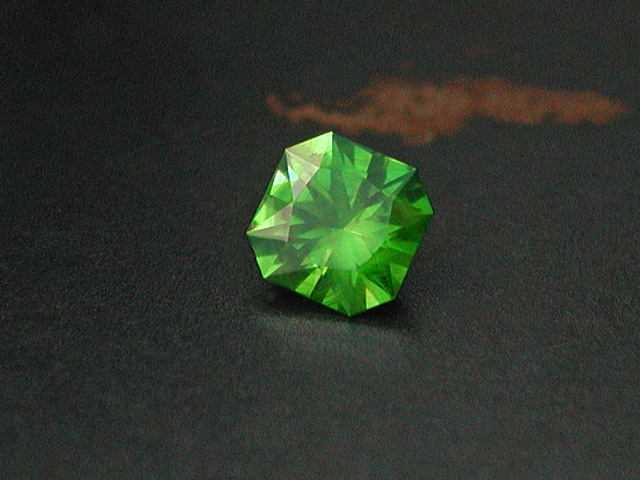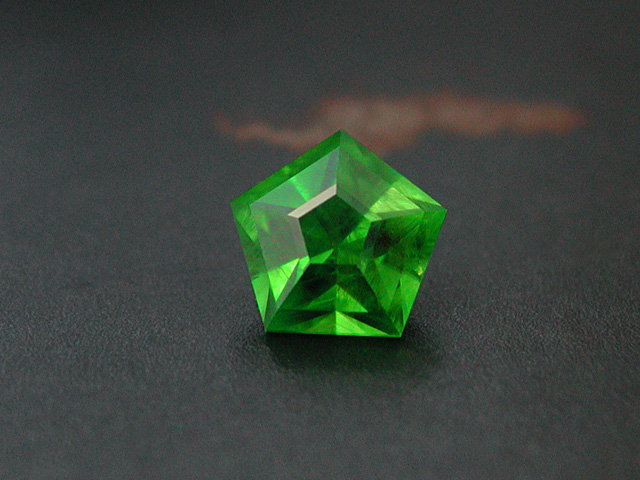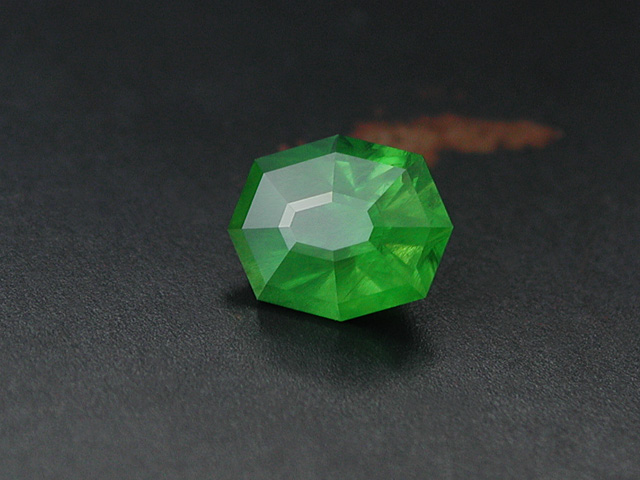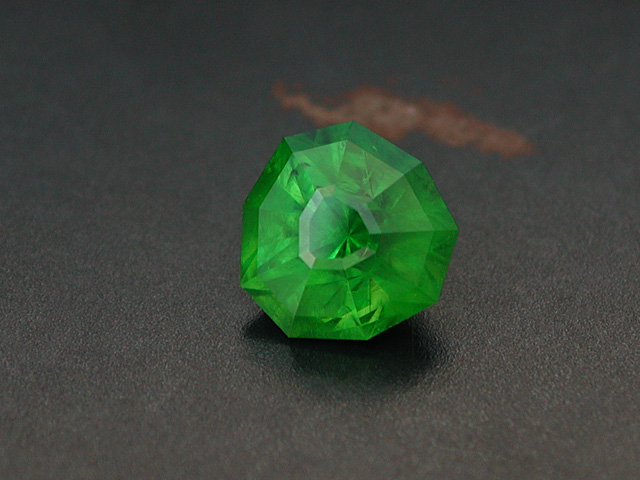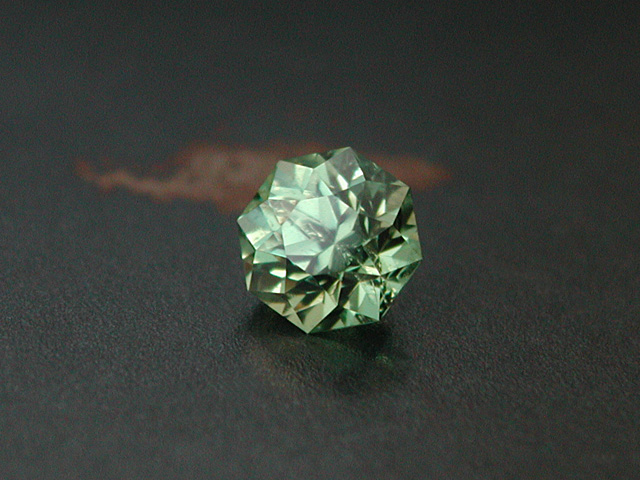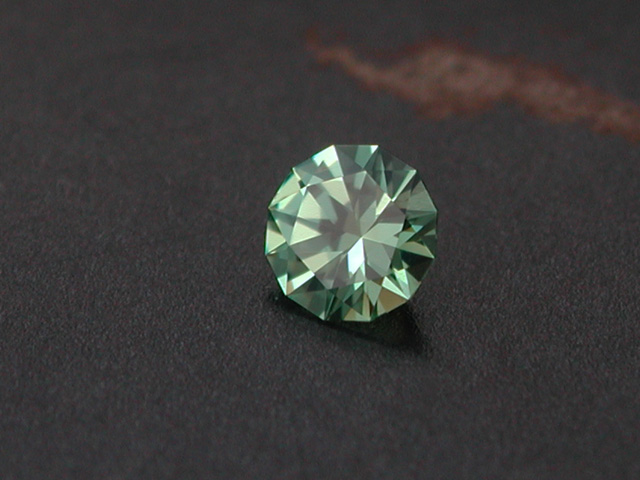Dear customers and friends!
Todays newsletter is totally different to all previously published ones. It's about one gem, 8 gemstones with a total weight of 7.77 carat, faceted from 4 rough stones, found in 3 localities all over the world and all share the same main colour: green. Other special properties are a very high RI around 1.87 to 1.89, a density of around 3.80, they belong to the Garnet family (that btw. has 3 other green members), two of those localities have been found in the last 30 years (Erongo in Namibia in 1996 and following years [total of 4!] and Madagascar in 2009) while the other locality in the Ural mountains was found a little over 154 years ago. When my grandfather's dad, who established our family's cutting factory, was born, nobody knew about these gems. There is another small dig very high in the italian alps in the "Val Malenco" that produced lighter tinies and often heavily included examples that was known in 19th century.
What I'm talking about is none other than the King of the Garnet family:
DEMANTOID
For years I was silently collecting Demantoid roughs and kept these treasures in a little box and waited until there is enough stuff to facet a series of these beauties. Often rough Demantoids looks so decent that nobody ever would expect they hide so much beauty & brillance inside. To be honest, I didn't had a detailed plan for that (and didn't that I would caught such big baby like hemispherical piece from Russia. I do this for many different gems and always hope to find examples from most different countries to have a variety of a gemstone from many different places, colours & specialities.
I have faceted some namibian Demantoids before, as well for me as some for a customer including a whopping 9.11 carat "Tudor's Kaleidoskop" from Erongo, Namibia. Early this year I had the great opportunity to acquire this big one from an older collection. It was found in the alluvials of the Bobrovka river south of Yekaterinburg and were brought to Germany after the collapse of the Sovietunion with the unbelievable flood of minerals russian collectors sold here to grab some western forex.
I'm not sure how many of you are faceters and have experienced with this rare and strong saturated, highly dispersive gemstone? It behaves completely different while being cut & polished compared with all other Garnets. Some points are (definitely no fun facts!!!): a strong anisotropy of its hardness combined with a much higher cutting hardness than the Mohs scale - 7 - might indicate. Some facets are smooth, other will get lots of tiny holes even with a very fine lap. It polishes easy but need extremely long for it (it works much better on a hard copper polishing lap than on an aluminum lap that all other Garnets prefer). If you polish a scratch into it you have to fight to get it out these are usually very deep. The russian Demantoids have the wellknown "Horsetail" inclusions that are caused by Chrysotile (Asbest) and makes polishing a bit challenging. The horsetail veils always have lines that meanders from inner parts to the outer areas not really radial but have a focus showing to the middle. Very interesting is the center. It has by far the best colour only here and there a single fine needle but it is useless due to many cracks. The facetable parts are around the pea-sized center and starts with the beginning horsetails and the colours becomes more yellowish. On the other hand you shouldn't use the parts directly under the surface because the colours turns to more yellowish with too much horsetails and often cracks from the alluvial transport.
The lines of the horsetail sometimes looks like scratches if these come to a facet, these are lines with many thin needles and didn't polish out.
Hemispherical Demantoids from Yekaterinburg, Ural Mauntains, Russia, slightly over 7 gram
While the average lost during faceting is around 80% the result of this one shows a much bigger lost.
The hemispherical nodule weighed slightly over 7 gram / 35 cts and the result is only 5.45 cts.
I have lost 84% of the original weight (only the sawing took 8 cts.!) and achieved a yield of 16%. An average Garnet of this shape would have a yield of 25 to 35%. Considering the beautiful but useless center, some cracks and the skin-troubles I'm still very happy with 5 fine gems of one of the rarest gemstones of the world. It was a hard work during April 2022, took much more time than expected and the results are just stunning and amazing.
"Family"-portrait of the 5 gems faceted from the hemispherical Demantoid nodule
- - -
Not to forget there are 3 more Demantoids from Erongo, Namibia and Madagascar.
On the first look these seems to be different gemstones. The reason must be a lower chromium content. One of these is nearly IF-clarity and shows a superb dispersion. My photography skills come to its limits. In daylight their colour is much more minty than the pics are showing (means less yellow).
As usual all gems are photographed under natural daylight on a cloudy day. The Demantoids shows a significant colour shift, the green colour turns to yellow in incandescent light.
Please always use natural daylight to admire your gems and compare the colours only with this real natural light.
The prices here at this site are the best I can offer you. All gems are faceted by me (except on the three gems from my students).
This offer is valid as long as you can see this site.
Insured shipping on all of these gems worldwide is included. There are a lot of pics here, please allow your browser a little time to load this long page.
For orders or if you have any question please feel free to contact me (osirisgems@yahoo.de or uli@osirisgems.com).
Demantoid Addendum June 2022:
Shortly after the last newsletter with the big russian Demantoids a new source for this green Garnet found its way to me. This time from Kerman in the south of Iran. On the first view these look very similar because of the dark green colour and also the crystals structure is nearly of the same kind with a troubleful core, a slightly lighter mass around the core and a more yellowish skin that is also full of cracks. The differences are no horsetails (I know they can have it, but these don't do so), the colour is a step darker and the crystals (rombic dodecaedron) are small & flat with sizes of up to 5-8 mm while the russian are rounded and easily reaches marble sizes of 20 mm The Kerman can used as whole piece of rough while the russians have to be splited multiple times into smaller pieces. Generally for all roughs I have received and faceted together with my students the clarity on one side is good because of no foreign stuff but on the other side they show numerous tiny cracks. No problem to handle these during the faceting process: nothing broke out but a lots of tiny dots have to be polished out. So I used a special polishing with two steps me teacher told me when I began faceting. First an abrasive one to remove very smoothly all issues and a last one that gives a glossy shine but it should be used only very decently to avoid roundish rims and corners. Anyway it worked and after some dozens of Demantoids I can say it is one the more challenging gemstones and me and my students have learned how handle a problematic gemstone close to perfection. Some of the results are now available for you:
| |
Kerman Demantoid The #2 in size and with good colour was faceted from one of my students into a sqarish design with 4triangles instead a table, an impressive gem! 1.09 cts., 5.1 x 4.4 mm |
|
|
||
| |
|
|
|
|
| |
Kerman Demantoid An octagon shaped students gem that shows how the colour lightens up in the smaller Demantoids. A stepcut design with a peak instead the table. 0.72 cts., 4.9 x 4.3 mm |
|
|
||
| |
|
|
|
|
| |
Kerman Demantoid The floret design in dark green works also in gems with intense internal life. 0.52 cts., 4.6 x 3.6 mm |
|
|
||
| |
|
|
|
|
| |
Kerman Demantoid Another octagon with a frosted middle-row and 8 pseudo-table facets. Don't know why my students don't like table, just aks them. 0.41 cts., 4.2 x 3.9 mm |
|
|
||
| |
|
|
|
|
(Please regard that all pics on this site are my own intellectual property and you are not allowed to use it in any way without my permission.)
